-
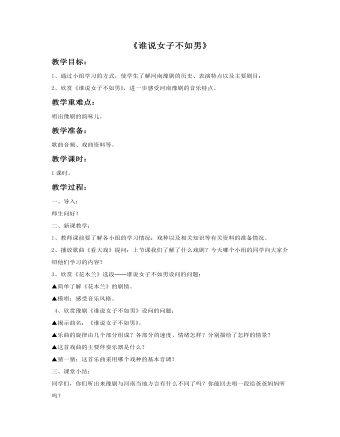
《谁说女子不如男》教案
教学过程: 一、导入:师生问好!二、新课教学:1、教师课前要了解各小组的学习情况:戏种以及相关知识等有关资料的准备情况。2、播放歌曲《看大戏》提问:上节课我们了解了什么戏剧?今天哪个小组的同学向大家介绍他们学习的内容? 3、欣赏《花木兰》选段──谁说女子不如男设问的问题:▲简单了解《花木兰》的剧情。▲模唱:感受音乐风格。 4、欣赏豫剧《谁说女子不如男》设问的问题:▲揭示曲名:《谁说女子不如男》。▲乐曲的旋律由几个部分组成?各部分的速度、情绪怎样?分别描绘了怎样的情景?▲这首戏曲的主要伴奏乐器是什么?▲猜一猜:这首乐曲采用哪个戏种的基本音调?
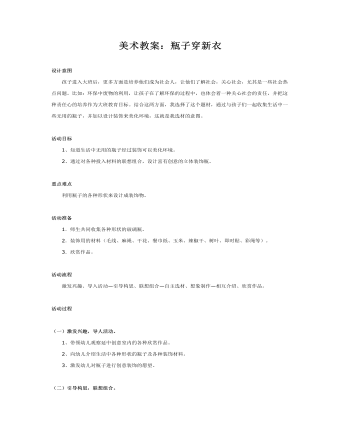
美术教案:瓶子穿新衣
活动目标1、知道生活中无用的瓶子经过装饰可以美化环境。2、通过对各种投入材料的联想组合,设计富有创意的立体装饰瓶。 重点难点 利用瓶子的各种形状来设计成装饰物。 活动准备1.师生共同收集各种形状的玻璃瓶。2.装饰用的材料(毛线、麻绳、干花、餐巾纸、玉米、辣椒干、树叶、即时贴、彩绳等)。3.欣赏作品。 活动流程 激发兴趣、导入活动—引导构思、联想组合—自主选材、想象制作—相互介绍、欣赏作品。 活动过程 (一)激发兴趣,导人活动。1、带领幼儿观察延中创意室内的各种欣赏作品。2、向幼儿介绍生活中各种形状的瓶子及各种装饰材料。3、激发幼儿对瓶子进行创意装饰的愿望。
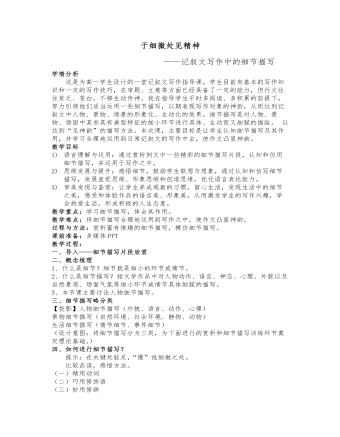
高中语文作文课教案说课稿模板
教学目标1) 语言理解与运用:通过赏析例文中一些精彩的细节描写片段,认知和仿用细节描写,并运用于写作之中。2) 思维发展与提升:感悟细节,鼓励学生联想与想象,通过认知和仿写细节描写,发展直觉思维、形象思维和创造思维,优化语言表达能力。3) 审美发现与鉴赏:让学生养成观察的习惯,留心生活,发现生活中的细节之美,感受和体验作品的语言美、形象美,从而激发学生的写作兴趣,学会热爱生活,形成积极的人生态度。
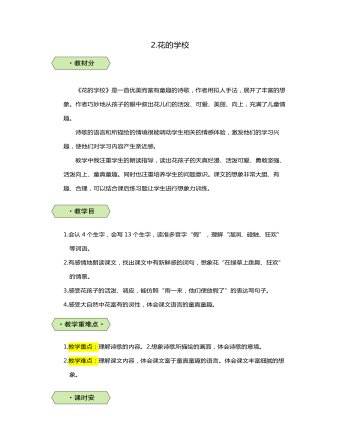
三年级语文花的学校教案
《花的学校》是一首优美而富有童趣的诗歌,作者用拟人手法,展开了丰富的想象。作者巧妙地从孩子的眼中叙出花儿们的活泼、可爱、美丽、向上,充满了儿童情趣。诗歌的语言和所描绘的情境很能调动学生相关的情感体验,激发他们的学习兴趣,使他们对学习内容产生亲近感。教学中我注重学生的朗读指导,读出花孩子的天真烂漫、活泼可爱、勇敢坚强、活泼向上、童真童趣。同时也注重培养学生的问题意识。课文的想象非常大胆、有趣、合理,可以结合课后练习题让学生进行想象力训练。
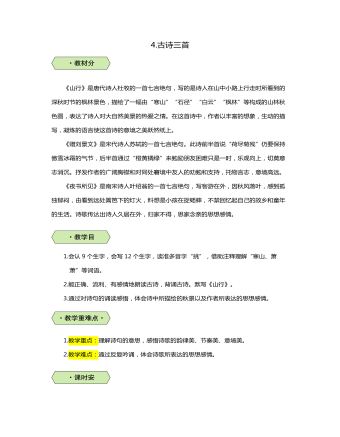
三年级语文古诗三首教案
《山行》是唐代诗人杜牧的一首七言绝句,写的是诗人在山中小路上行走时所看到的深秋时节的枫林景色,描绘了一幅由“寒山”“石径”“白云”“枫林”等构成的山林秋色图,表达了诗人对大自然美景的热爱之情。在这首诗中,作者以丰富的想象,生动的描写,凝炼的语言使这首诗的意境之美跃然纸上。《赠刘景文》是宋代诗人苏轼的一首七言绝句。此诗前半首说“荷尽菊残”仍要保持傲雪冰霜的气节,后半首通过“橙黄橘绿”来勉励朋友困难只是一时,乐观向上,切莫意志消沉。抒发作者的广阔胸襟和对同处窘境中友人的劝勉和支持,托物言志,意境高远。《夜书所见》是南宋诗人叶绍翁的一首七言绝句,写客游在外,因秋风落叶,感到孤独郁闷,由看到远处篱笆下的灯火,料想是小孩在捉蟋蟀,不禁回忆起自己的故乡和童年的生活。诗歌传达出诗人久居在外,归家不得,思家念亲的思想感情。

语文下册教案找春天
图文对照,读中感悟1.学习第1、2自然段。师:要去野外找春天了,课文中的小朋友现在是怀着什么样的心情呢?(高兴的、急切的、激动的)请你也带着这样的心情读一读第一、二自然段吧?自由读。指名读本段,读后评价悟出应把“脱”、“冲”、“奔”重读才能更加体现出孩子们找春天的迫切心情。2.请大家自由读第3 ~7自然段,想一想,作者把春天想象成什么了(一个害羞的小姑娘)。这个害羞的小姑娘,遮遮掩掩、躲躲藏藏的,不想让人们发现她。可是细心的小朋友还是找到了她。这些小朋友都在哪找到她了?你知道吗?从书中找到有关的句子再读一读。(学生边画、边读。)小草从地下探出头来,那是春天的眉毛吧?早开的野花一朵两朵,那是春天的眼睛吧?树林吐出点点嫩芽,那是春天的音符吧?解冻的小溪丁丁咚咚,那是春天的琴声吧?
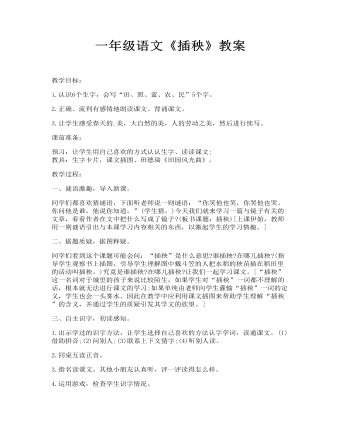
一年级语文《插秧》教案
一、谜语激趣,导入新课。同学们都喜欢猜谜语,下面听老师说一则谜语:“你笑他也笑,你哭他也哭。你问他是谁,他说你知道。”(学生猜。)今天我们就来学习一篇与镜子有关的文章,看看作者在文中把什么写成了镜子?(板书课题:插秧)[上课伊始,教师用一则谜语引出与本课学习内容相关的东西,以激起学生的学习情趣。]二、据题质疑,据图释疑。同学们看到这个课题可能会问:“插秧”是什么意思?谁插秧?在哪儿插秧?(指导学生观察书上插图,引导学生理解图中戴斗笠的人把水稻的秧苗插在稻田里的活动叫插秧。)究竟是谁插秧?在哪儿插秧?让我们一起学习课文。[“插秧”这一名词对于城里的孩子来说比较陌生,如果学生对“插秧”一词都不理解的话,根本就无法进行课文的学习;如果单纯由老师向学生灌输“插秧”一词的定义,学生也会一头雾水。因此在教学中应利用课文插图来帮助学生理解“插秧”的含义,并通过学生的质疑引发其学文的欲望。]
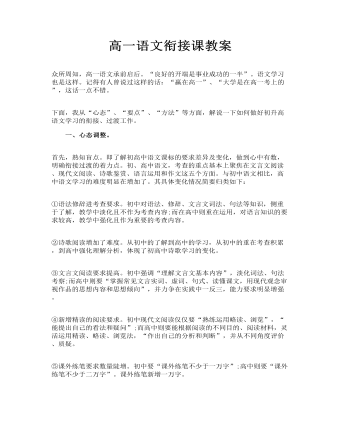
高一语文衔接课教案
一、心态调整。 首先,熟知盲点。即了解初高中语文课标的要求差异及变化,做到心中有数,明确衔接过渡的着力点。初、高中语文,考查的重点基本上聚焦在文言文阅读、现代文阅读、诗歌鉴赏、语言运用和作文这五个方面。与初中语文相比,高中语文学习的难度明显在增加了。其具体变化情况简要归类如下: ①语法修辞进考查要求。初中对语法、修辞、文言文词法、句法等知识,侧重于了解,教学中淡化且不作为考查内容;而在高中则重在运用,对语言知识的要求较高,教学中强化且作为重要的考查内容。 ②诗歌阅读增加了难度。从初中的了解到高中的学习,从初中的重在考查积累,到高中强化理解分析,体现了初高中诗歌学习的变化。
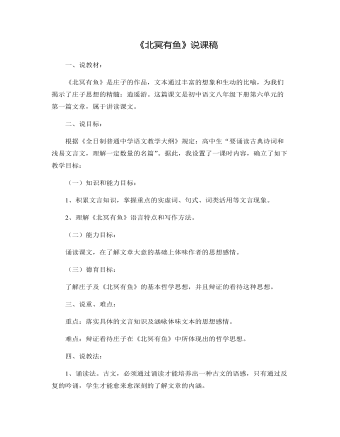
部编版语文八年级下册《庄子》二则 说课稿
一、说教材:《北冥有鱼》是庄子的作品,文本通过丰富的想象和生动的比喻,为我们揭示了庄子思想的精髓:逍遥游。这篇课文是初中语文八年级下册第六单元的第一篇文章,属于讲读课文。二、说目标:根据《全日制普通中学语文教学大纲》规定:高中生“要诵读古典诗词和浅易文言文,理解一定数量的名篇”。据此,我设置了一课时内容,确立了如下教学目标:(一)知识和能力目标:1、积累文言知识,掌握重点的实虚词、句式、词类活用等文言现象。2、理解《北冥有鱼》语言特点和写作方法。(二)能力目标:诵读课文,在了解文章大意的基础上体味作者的思想感情。(三)德育目标:了解庄子及《北冥有鱼》的基本哲学思想,并且辩证的看待这种思想。

人教版小学语文下册说课稿《学弈》《两小儿辩日》
一、说教材 1.教材内容:九年义务教育六年制小学语文第十一册第八组第二十五课《学弈》。 2.教材简析:《学弈》这篇文言文选自《孟子·告子》,通过弈秋教两个人学下围棋的事,说明了做事必须专心致志,决不可三心二意的道理。文章先说弈秋是全国最擅长下围棋的人,然后讲弈秋同时教两个学习态度不同的人下围棋,学习效果截然不同,最后指出这两个人学习结果不同,并不是在智力上有多大差异。文言文是古代文明传承的媒介,虽与现代文在用词造句、朗读上有很大差别,但两者却有着千丝万缕、不可分割的内在联系
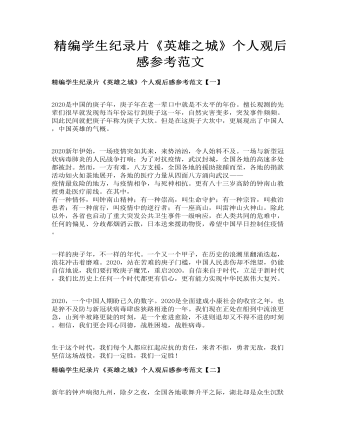
精编学生纪录片《英雄之城》个人观后感参考范文
一样的庚子年,不一样的年代。一个又一个甲子,在历史的浪潮里翻涌迭起,浪花冲击着磨难。2020,站在苦难的庚子门槛,中国人民悲伤却不绝望,仍能自信地说,我们要打败庚子魔咒,重启2020。自信来自于时代,立足于新时代,我们比历史上任何一个时代都更有信心,更有能力实现中华民族伟大复兴。 2020,一个中国人期盼已久的数字。2020是全面建成小康社会的收官之年,也是猝不及防与新冠状病毒肆虐狭路相逢的一年。我们现在正处在船到中流浪更急,山到半坡路更陡的时刻,是一个愈进愈险,不进则退却又不得不进的时刻。相信,我们更会同心同德,战胜困境,战胜病毒。 生于这个时代,我们每个人都应扛起应抗的责任,来者不拒,勇者无敌,我们坚信这场战役,我们一定胜,我们一定胜!
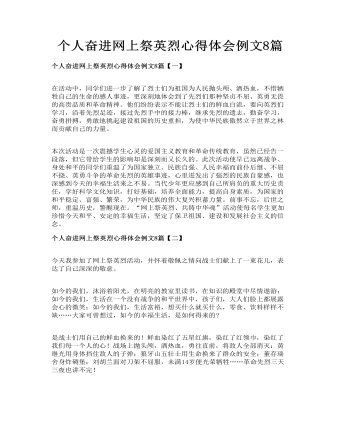
个人奋进网上祭英烈心得体会例文8篇
如今的我们,沐浴着阳光,在明亮的教室里读书,在知识的殿堂中尽情遨游;如今的我们,生活在一个没有战争的和平世界中,孩子们,大人们脸上都展露会心的微笑;如今的我们,生活富裕,想买什么就买什么,零食、饮料样样不缺……大家可曾想过,如今的幸福生活,是如何得来的? 是战士们用自己的鲜血换来的!鲜血染红了五星红旗,染红了红领巾,染红了我们每一个人的心!战场上抛头颅,洒热血,勇往直前,将敌人全部消灭:黄继光用身体挡住敌人的子弹;狼牙山五壮士用生命换来了群众的安全;董存瑞舍身炸碉堡;刘胡兰面对刀架不屈服,未满14岁便光荣牺牲……革命先烈三天三夜也讲不完!
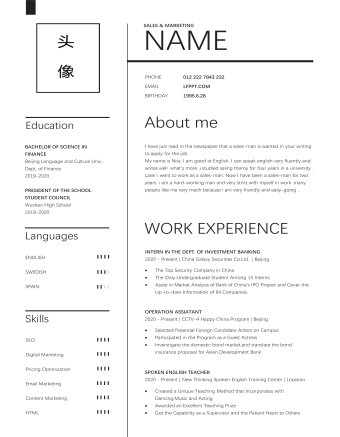
简洁黑白商务销售英文简历模版
INTERN IN THE DEPT. OF INVESTMENT BANKING2020 - Present | China Galaxy Securities Co.Ltd. |Beijing· The Top Security Company in China· The Only Undergraduate Student Among 15 Interns· Assist in Market Analysis of Bank of China's IPO Projectand Cover the Up-to-date Information of 64 Companies· Selected Potential Foreign Candidate Actors on Campus· Participated in the Program as a Guest Actress· Inverstigate the domestic bond market,and translatethe bond insurance proposal for Asian Development Bank
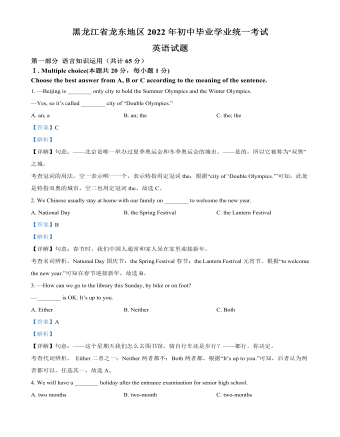
2022年黑龙江省龙东地区中考英语真题(解析版)
Choose the best choice fromA to F to finish the dialogue. You have one more answer. Each choice should beused only once.A: Hello, I’m a schoolnewspaper reporter. May I ask you some questions?B: ____46____
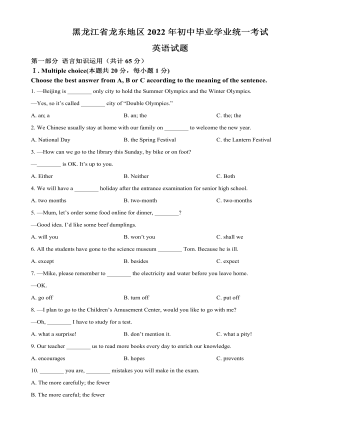
2022年黑龙江省龙东地区中考英语真题(原卷版)
B: It’s about theexperiments three astronauts are doing on the space station.A: That’s great. I’minterested in space, so I want to be an astronaut like them.
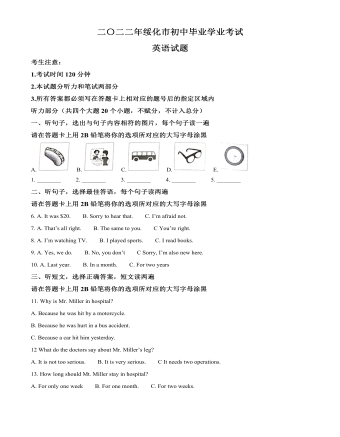
2022年黑龙江省绥化市中考英语真题(解析版)
There are many kinds ___21___art forms in China. ___22___ you often see any of them in your life?They help us understand and enjoy the traditional Chinese culture. When theSpring Festival comes, some people often ___23___ the red paper intodifferent art works with scissors.
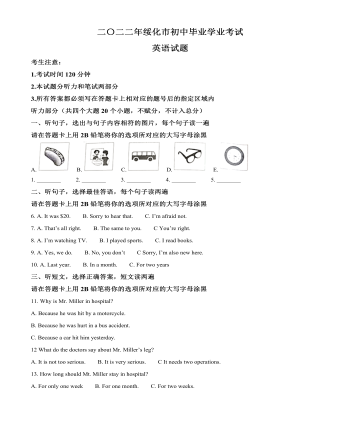
2022年黑龙江省绥化市中考英语真题(原卷版)
Tim: _______36_______,Bob.Bob: Good afternoon, Tim. Icalled you just now, but nobody answered. _______37_______?Tim: I went to the cinema.And I watched a movie named The Battle atLake Changjin.Bob: Oh, great. It’s very famous nowadays. _______38_______?
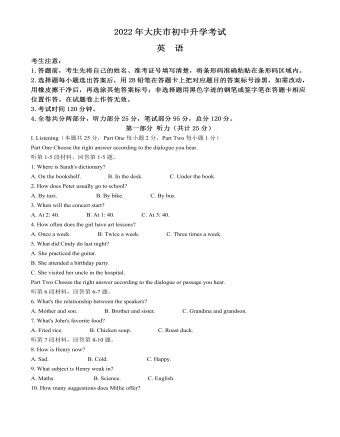
2022年黑龙江省大庆市中考英语试题(解析版)
On a snowy day, there was a man walking in ahurry on the road. His clothes were in poor condition. You might think he was abeggar(乞丐),but in fact he was a painter. His name was Vincent Willem van Gogh.
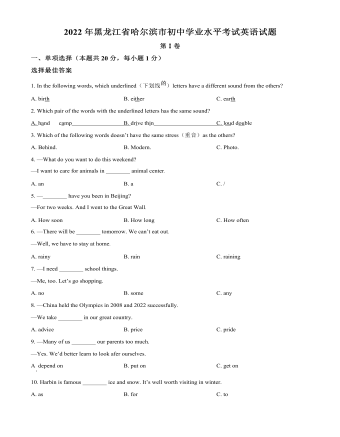
2022年黑龙江省哈尔滨市中考英语真题(原卷版)
I often use old clothes that people don’t wearany more to make bags. I opened a small shop in my community and set up awebsite to sell the bags online. Many customers think they are fantastic. Now Iplan to write a new book about ways to use old clothes.
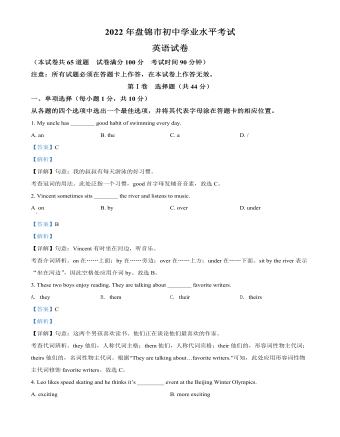
2022年辽宁省盘锦市中考英语真题(解析版)
Remember that it’s better to fail than it’s togive up, and the key is to learn from your failure(失败). But along withdifficulties, there will also be ____18____ wonderful waiting for you.

